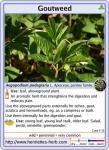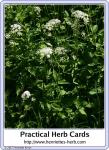
 Goutweed is mildly spicy (aromatic) and mildly bitter. The taste has a hint of aniseed.
Goutweed is mildly spicy (aromatic) and mildly bitter. The taste has a hint of aniseed.
Because it's aromatic and bitter, it's warming (very mildly) and drying.
Use the root and aboveground parts externally for various pains, especially gout and sciatica. Try them for other pains as well! It's also been used, externally, for hemorrhoids.
Make a poultice or compress, or a bath. For poultices and compresses you need to bring 1 liter (1 quart) fresh herb to a boil in 2 liters (2 quarts) of water.
Compress: dip a piece of cloth in the tea and wring out excess liquid. Let cool until bearable and apply to the aching part. Cover with a towel to avoid goutweed stains.
Poultice: fold a handful or two of the hot herb into a piece of cloth, let cool until bearable and apply to the aching part. Cover with a towel.
Leave either in place for about 30 minutes, and apply at most two a day.
Goutweed works internally too, for gout and similar pain. Pour 200 ml (8 fl.oz.) boiling water over 2 tsp fresh or 1 tsp dried herb, let steep for 10 minutes, strain. Drink 1–3 cups a day.
As a wild green, goutweed is rather versatile. Add young leaf to salads, make them into pesto, add them to omelettes, stews or soups or chop them up and use them as spinach.
Serve crisp young leaf stalks with one or the other delicious sauce, eg. bearnaise.
Dry older leaf, powder it up and use it as one of the main herbs in your green powder.
Henriette's herb cards: order yours here!

